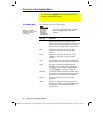
Chapter 3: Symbolic Manipulation 69
03SYMBOL.DOC TI-89/TI-92 Plus: Symbolic Manipulation (English) Susan Gullord Revised: 02/23/01 10:52 AM Printed: 02/23/01 2:12 PM Page 69 of 24
Many identities and transformations are valid for only a particular
domain. For example:
ln(x
ù
y) = ln(x) + ln(y)
only if
x
and/or
y
is not negative
sin
ê
(sin(
q
)) =
q
only if
q
‚
ë
p
/2
and
q
p
/2
radians
Use the “with” operator to specify the domain constraint.
In many cases, you can
achieve the same effect
as a substitution by
defining the variable.
However, substitution is preferable for most cases because the
variable is defined only for the current calculation and does not
accidentally affect later calculations.
Specifying Domain
Constraints
Tip: Enter
ln(x
ù
y)
instead o
f
ln(xy)
; otherwise, xy is
interpreted as a single
variable named xy.
Tip: For
‚
or
, press
¥Ã
or
¥Â
. You can also use
2I
8
or
2¿
2
to
select them from a menu.
Using Substitutions
vs. Defining a
Variable
Caution: After x is defined,
it can affect all calculations
that involve x (until you
delete x).
Because ln(x
ù
y) = ln(x) + ln(y) is not always
valid, the logarithms are not combined.
With a constraint, the identity is valid
and the expression is simplified.
Because sin
ê
(sin(
q
)) =
q
is not always
valid, the expression is not simplified.
With a constraint, the expression can
be simplified.
Storing 1
!
x affects
the subsequent
calculations.
Substituting x=1 does
not affect the next
calculation.


















